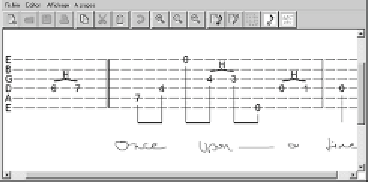Information Technology Reference
In-Depth Information
Figure 18. Screenshot of the stringed-instrument
tablature composition and editing prototype:
example of a more complex document
Then, punctums, and virgas can be joined to
constitute various neumes. Most current neumes
are constituted of one to three notes. Table 5
introduces some of these symbols as well as the
two existing clefs (the C-Clef and the F-Clef), and
some interpretation rules which have been used
to design the corresponding pen-based composi-
tion and editing system. The authors would like
to highlight the fact that there are no constraints
in the order of the drawings in the sub-elements
of all the presented symbols. As a consequence,
the resulting system is very user-friendly, because
the user can draw the symbols in any order, as he
does on a sheet of paper.
The developed system enables the user to draw
as many staves as possible; it is possible to write
the lyrics under these staves. Figure 15 presents
two screenshots of this system, on the left the
user strokes and on the right the corresponding
interpreted document. As it can be seen on this
figure, we have not yet coupled this prototype
with a handwritten text recognizer: thanks to the
context in which they are drawn, such strokes are
identified as being text, but are not interpreted; as
a consequence, we keep the strokes under their
handwritten form.
About 20 rules model the eager interpretation
process for this system. Its performances are even
slightly better than the one for traditional musical
score notations because the number of available
symbols (and as a consequence of interpretation
rules) is reduced.
ents an antiphonary of the middle of the twelfth
century with such notations.
One of the main characteristic of the plainchant
score notations is the diversity of the existing
systems. Contrary to classical musical score
notations, very standardized since the classical
epoch, plainchant melodies have been written with
very different notations. For instance, rhythms
can be represented according to a modal system
(i.e., based on the representation of short rhyth-
mic cells), like for the “Ecole de Notre-Dame de
Paris” in the XII century. On the opposite, the
mensuralist notation, since last century, adopts a
connection between the duration of a sound and
the shape of the isolated note. This is the cause of
lots of difficulties for usual musical composition
software, which are therefore often adapted to very
simplified plainchant notations. Only a formalism
like the one we propose makes it possible to deal
with such difficulties, by offering the possibility
to easily modify composition conventions in order
to adapt to different notations.
Among different variants for plainchant nota-
tions, some have started to be standardized since
the XIVth century. In the continuation of this sec-
tion, we focus on one example of these notations.
It includes two kinds of simple notes: the
punctum
,
which is a filled-square, and the
virga
, which is a
filled-square with a stem. Table 4 presents three
interpretation rules, which model the eager rec-
ognition of punctums, vertical segments (which
can become, afterwards, stems) and virgas.
drum tablature notations
Notations for percussion instruments are less
normalized than notations for other instruments.
We focus here on drum tablatures. Contrary to
traditional musical scores, which can represent
music for any singer or instrument, tablatures are
musical notations adapted to specific instruments.
The graphical metaphor is no longer based on
the pitch in the acoustic sense of the term, but

Search WWH ::

Custom Search